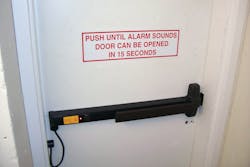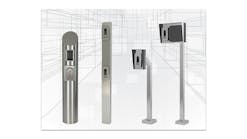When dealing with an existing exit device, one popular approach to upgrading a door to electronic access control is to upgrade the exterior lever trim. Replacing the trim is more cost effective that replacing both the exit device and the trim.
Electrified trim is not appropriate for certain situations, such as if the door is equipped with an automatic door operator, or if electric dogging is a requirement.
With electrified trim, the door provides free egress at all times, but the exterior lever remains locked until electrically signaled to permit actuation. Electrified trim is available in both failsafe and fail secure versions. However, the door remains positively latched until the trim is actuated by a person’s hand.
Some exit device manufacturers do not offer electrified trim or electrified trim for all their products. Some manufacturers send their non-electrified levers to third party vendors to upgrade them then sell the electrified trim as a catalog item.
Frequently when encountering older exit devices, electrified trim was not originally available from the manufacturer. Again third party manufacturers are available to fill this void.
With a vast number of exit devices out there, the challenge is to find a third party manufacturer who has trim which will work with your particular exit device.
While it may be expedient to plug in a budget number when working up a proposal or bid, it will be necessary to carefully evaluate the door hardware in so you can specify the correct model trim. With older exit devices, determining the model number may not be easy.
Case Study
On a recent mandatory pre-bid walkthrough, some installers actually declined to bid the job because door hardware of this type was requested by the owner.
The competitors did their best to convince the owner that due to the type of door and existing hardware, the only electric solution was an electromagnetic lock.
I knew I could get an electrified lever for these doors, and had to go to great lengths to convince owner.
One issue I always ponder when recommending the re-use of an existing exit device, especially an orphaned product, is that I will inherit used hardware and will have to repair it when the mechanical parts ultimately fail.
Another consideration is that maglocks are easy to mount on just about nay door.
However the maglock will unlock in a power failure which is a concern for many customers, the maglock is not positive latching, and code issues associated with electromagnetic lock deployment must be addressed which can add substantially to the job price.
There are many situations where a maglock is the best choice, but there also are situations where a maglock is not the best choice. We are the security professionals, and our customers rely on us for accurate information.
Needless to say the other bidders in the cited case history who insisted maglocks were the only solution, (and then were proved to be wrong) were not providing accurate information to the end-user and it cost them points with this client.
Voltage Transfer
If electrified trim is going to be used, then a means of transferring the control voltage from the frame to the lever must be specified. There are several ways to accomplish this.
Perhaps the least expensive is an armored door cord. Back in the day, these were originally used by the alarm installers to connect foil on movable windows and doors to the premises alarm protective circuit. These evolved to loops specifically designed for use in access control. These used flexible armored cable and more robust mounting on the frame and door.
Wired hinges, such as the Marray PTH mentioned in another article this month, are another solution. They are less subject to abuse than exposed door cords.
Another choice is the EPT (electric power transfer). This device is less convenient than a hinge because it requires its own prep rather than fitting into the existing hinge prep. The advantage is that there are more options for choice of wire conductors with an EPT. In my experience, the additional cost of the EPT is often offset in the customer’s mind by the wow-factor of the EPT which is fascinating in its design, attractive when installed and a highly effective solution.
Solutions From Securitech®
Established in New York City in 1983, Securitech® is an independent manufacturer of high-security door locks. Originally founded to create and produce multi-point door locks, Securitech quickly added automatic deadbolt locking and electric locking solutions to its catalog of products.
Securitech works closely with fire and life-safety official to ensure that all products respect code requirements while providing the desired level of protection against forced entry and vandalism. Securitech products exceed UL and have earned the hard-to-achieve ""SB Tested" label; field-tested in the South Bronx to withstand the toughest levels of abuse.
Control Trim: Electric release in the trim … not the strike. This field-proven method provides maximum durability with easy installation and system integration. Key override provides entry in the event of power failure, and an optional key usage switch indicates the cylinder has been used in place of the access control system.
Control Trim & Signal Locks are available for use with a wide variety of door locks to meet virtually any locking need.
GG Trim: This durable and vandal resistant trim works for many applications. The attractive GG trim is available in most common plated finishes.
GG Exterior Trim Features include:
- Narrow design with many finish choices
- Works with mortise cylinders
- Cylinder held in place at two points
- Independent coil lever spring prevents lever from sagging
- LeverEx2TM slip clutch lever handle
- Internal handle stop prevents rotation of lever beyond 70o
- ADA compliant lever handle
- Thru-bolted design
- GG Interior Trim Features
- Attractive architectural design
- Built-in lever movement restrictor
- ADA compliant lever handle
- Optional request-to-exit available
Slip-Clutch Lever: The GG style exterior trims include Securitech’s LeverExTM slip-clutch apparatus inside each trim exterior lever handle. If the handle is forced while in locked mode, it breaks away without unlocking the door and the lock and lever are not damaged.
Resetting the lever is easy and does not require any tools or replacement parts. If the lever is forced downward, simply pick it back up. It will “lock” back into the correct position.
When required, custom mounting plates are available for use with different manufacturers’ exit devices. Cylinders are held in place at two points, not one point as in ordinary locks and trim. It is used on the GG trims.
For more information, contact your local locksmith distributor or Securitech, 54-60 46th St., Maspeth, NY 11378. Telephone: 800-622-5625. Web Site: www.securitech.com.
Securitron CEPT
The Concealed Electrical Power Transfer CEPT unit is a relatively recent entry into the electronic access control hardware market. It is designed to provide a secure multiple wire power and/or data transfer between a door frame and door. The unit mounts directly between the frame and door along the hinged edge and is available in three multi-wire configurations.
The CEPT is non-handed, allows mechanical (hinged) movement of the door and is totally concealed when the door is fully closed. This manual provides the information required to successfully install a CEPT to a standard hinged door opening.
Concealed Electrical Power Transfer features include:
- Mortises into the edges of the door and frame
- Tamper resistant. No exposed openings prevents foreign objects from reaching the wires or jamming the device
- All metal construction including back boxes - no plastic
- 10 wire configuration includes 2-18 gauge wires for higher current devices
- Available with CAT-5E and ElectroLynx compatible connectors
- Four architectural finishes: US32, US04, US10 and US10B
- Installs above 2nd hinge
- 7/8" knockouts on back boxes accommodate EMF-type fittings
- Tested to 1,000,000 cycles
- Will only function with butt hinges - up to 6"
- Will not work on center-hung or balanced doors
- Will work with Continuous Hinges - check with Continuous Hinge Manufacturer as to their cutout availability and charge for this cutout
How To Order
Part# CEPT-10: 2-18 AWG wires, 8-22 AWG wires, US32D finish
Part# EL-CEPT: 12-22 AWG wires, ElectroLynx connectors, US32D finish
Part# CEPT-C5E: 9-22 AWG wires, stranded conductor, Molex connectors, US32D finish
Part# CEPT-10-04: 2-18 AWG wires, 8-22 AWG wires, US04 finish
Part# EL-CEPT-04: 12-22 AWG wires, ElectroLynx connectors, US04 finish
Part# CEPT-C5E-04: 9-22 AWG wires, stranded conductor, Molex connectors
Part# CEPT-10-10: 2-18 AWG wires, 8-22 AWG wires, US10 finish
Part# EL-CEPT-10: 12-22 AWG wires, ElectroLynx connectors, US10 finish
Part# CEPT-C5E-10: 9-22 AWG wires, stranded conductor, Molex connectors
Part# CEPT-10-10B: 2-18 AWG wires, 8-22 AWG wires, US10B finish
Part# EL-CEPT-10B: 12-22 AWG wires, ElectroLynx connectors, US10B finish
Part# CEPT-C5E-10B: 9-22 AWG wires, stranded conductor, Molex connectors,
For more information, contact your local locksmith distributor or Securiton Magnalock Corp., 10027 S. 51st St., Suite 102, Phoenix, AZ 85044. Telephone: 800-MAGLOCK. Web: www.securitron.com.






